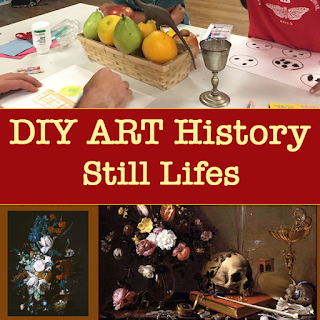 After covering the manuscripts of the middle ages, we wanted to talk about one of the great art forms of the renaissance. We picked Still Lifes, because we discovered that the objects of those paintings often conveyed a surprising amount about the society they were painted in. We even went into the somewhat somber subgenre of Vanitas, and found that the kids had really interesting insights about the nature of life, death, and vanity.
After covering the manuscripts of the middle ages, we wanted to talk about one of the great art forms of the renaissance. We picked Still Lifes, because we discovered that the objects of those paintings often conveyed a surprising amount about the society they were painted in. We even went into the somewhat somber subgenre of Vanitas, and found that the kids had really interesting insights about the nature of life, death, and vanity.After our discussion, the kids made pastel drawings at still life stations scattered throughout the classrooms. Some of those drawings were *deep*.
Here's the presentation, lesson plan, supplies, and additional resources:
Presentation:
Using these slides:
Lesson Plan:
- Pass still life examples around
- Slide/Q: What kind of objects do you see in them?
- Slide/Q: How would you define a still life?
- Slide: When were they made?
- Slide: What was happening then?
- Q: Let’s see what was happening right before then. Does anybody know what happened in 1492? A: Columbus sailed the ocean blue!
- Slide: Global Trade
- That’s when lots of sailing and global trade started, with routes all around the Americas and Asia.
- Slide: Global Trade #2
- Europeans got exotic foods that they never had before, like chocolate, avocados, and tomatoes.
- Slide: Antwerp
- This was an important trading city and in a big part because of that, it became an important city for still lifes.
- People started earning a lot of money there - it was the first time we started to have a middle class that could actually afford art. Before this time, most paintings were funded by the church or by nobles.
- Slide: Flowers
- This still life is of multiple flowers that actually bloom at different times, so the artist used some imagination.
- Q: Do you know what sort of flower it is? A: It’s a tulip, which was imported from Turkey. The Dutch people went crazy for Tulips, it was called tulipmania. Back then, you could trade a tulip for a whole hour.
- The striped tulip in this painting is even more special, because it’s striped. The stripes actually come from a virus which infects a tulip and changes its colors.
- Slide: Exotic/luxurious food
- Many of the still lifes show off how well the middle class were able to eat - like local delicacies, expensive foods, and imported foods.
- This one shows oysters, from the Dutch fishing industry. It also shows bread, figs, wine, desserts. It displays them in porcelain dishes, which were probably imported.
- Slide: Game
- This one shows off “game”, dead rabbits and birds.
- Q: Why do you think showing a dead rabbit is showing off abundance? A: Possible reason - you needed $$ to have land/leisure time, so being able to hunt showed off wealth.
- Slide: Vanitas
- This is a different sort of painting, called vanitas, which means “vanity”.
- Q: Do you know what vanity is? A: Vanity means obsessing over your self, especially your attractiveness and material treasures.
- Vanitas paintings were commentaries on the vanity of human life and the fleeting nature of material pleasures / life. Each object had meaning.
- Watch - fleeting nature, use time wisely
- Skull - life is short, beware, put more emphasis on spiritual
- Book - knowledge, limits of human knowledge
- Coins - Trade or the inadequacy of human riches compared to the divine
- Q: What would you paint to show the short-lasting nature of human life, and how vain humans are?
- Slide: How were they made?
- A: Oil paint. Oil paint allowed them to be very realistic- it also takes a lot longer to dry, so we’re going to use oil pastels instead of paint.
- Slide: DIY time!
Supplies:
We got most of our supplies from the local SCRAP store in SF, but I've included Amazon links to similar items for convenience.
- Oil pastels
- Thick pastel paper
- Print-outs of example still lifes: Still life with Skull and Quill, Still life with lobster and fruit, Still life: A vase with flowers, Vanitas, Still life of a Dead Hare, Dishes with Oysters, Fruit, Wine, Vase with Flowers
- Objects to draw: skulls, stopwatches (have my watch), hand mirrors, flowers, fruit, gilted silver cups, exotic porcelain, glassware, hourglass, baskets

No comments:
Post a Comment